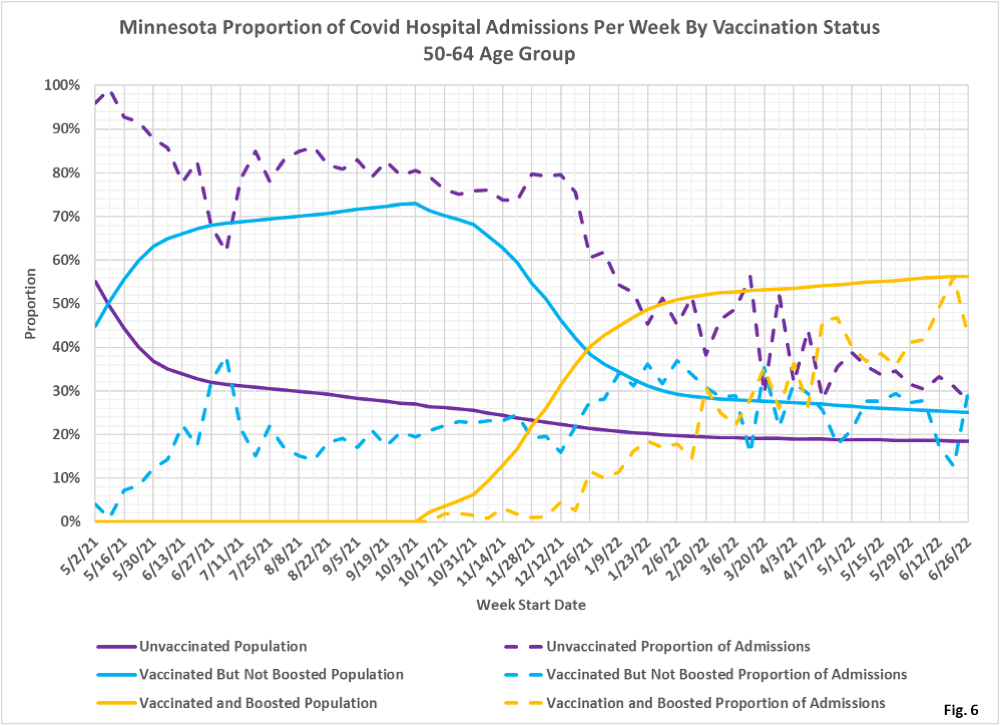Another older group that has high vax and booster rates. Boosters in particular appear worthless against infection, but vaccination does appear to lower hospitalization risk, although that protection is clearly diminishing over time.








 Dave’s notes:
Dave’s notes:
- The following charts illustrate, for the 50-64 year old age group, that being vaccinated and boosted appears to offer modest protection for being hospitalized or dying from Covid, in the most recent data, while the boosted actually have higher rates of testing positive than the unvaccinated or vaccinated but not boosted.
- This post is an update to the 50-64 age groups charts most recently published here: https://healthy-skeptic.com/
2022/06/29/breakthrough- events-ages-50-to-64-june-27/. - There are 9 charts in this set, 3 charts each for cases, hospital admissions, and deaths. Each set of 3 charts consists of the actual events per week (cases, admissions, or deaths); the rate per 100k each week, and the proportion of events compared to the proportion of the vaccinated population.
- Fig. 1: This chart plots the cases in the 50-64 age group per week among the unvaccinated, vaccinated but not boosted, and vaccinated and boosted populations each week. Since the week of 1/30/2022 there have been more cases each week among the boosted, rather than among the vaccinated but not boosted, or unvaccinated. The boosted are the largest subgroup, so it is not surprising that this group would have a majority of the weekly cases.
- Fig. 2: This chart displays the case rates per 100k for each subgroup in the 50-64 age group. The boosted and the unvaccinated have had nearly identical rates of cases per 100k for the last several months (except for what we believe is a data anomaly on 6/12/2022) with the vaccinated but not boosted having the lowest rate of Covid infection.
- Fig. 3: This chart displays the proportion of the 50-64 population who are unvaccinated (solid purple), vaccinated but not boosted (solid blue), and vaccinated and boosted (solid gold). For each population group we also display the proportion of cases each week (dashed lines of same color). Note that as people are boosted they are moved from the vaccinated subgroup to the boosted subgroup. The way to interpret this chart is to compare the proportion of breakthroughs to the proportion of vaccinations for each group. Whenever the dashed breakthrough proportion line is below the solid vaccination line of the same color, then that category is underrepresented for population, and that vaccination status might be said to be beneficial (ignoring for now other confounding factors). For the week of 6/26/2022, for example, 56% of this age group was vaccinated and boosted (solid gold line) while this group accounted for 61% of the cases (dashed gold line). We would interpret this to show that being boosted did not reduce an individual’s chances of testing positive for Covid for this week.
- Fig. 4-6: These charts display the hospital admissions, hospital admission rates per 100k, and hospital admissions proportions for the 50-64 age group, in an identical format to the case charts in Fig. 1 through Fig. 3. The boosted have had the highest number of hospital admissions for the past several weeks (Fig. 4), however the admissions per 100k for the unvaccinated are highest, with the vaccinated being second highest, and the boosted having the lowest rates of admissions for the week 6/26/2022 (Fig. 5). Fig. 6 shows that admissions among the unvaccinated have been disproportionately high throughout the pandemic (dashed purple curve compared to solid purple curve). Admissions among the boosted remain disproportionately low compared to the boosted proportion of the population (dashed gold curve compared to solid gold curve).
- Fig. 7-9: These charts display the deaths, deaths rates per 100k, and deaths proportions for the 50-64 age group, in an identical format to the case charts in Fig. 1 through Fig. 3. The number of deaths reported in this age group in recent weeks is low enough that it is difficult to draw conclusions (Fig. 7). Fig. 8 shows that the rates of death per 100k for each subgroup is also very low in the most recent months of data. Fig. 10 shows that deaths proportions are highly variable, especially in recent weeks when there are relatively few deaths.
- All data is obtained from the Minnesota Department of Health (MDH) Vaccine Breakthrough Weekly Update web site https://www.health.state.mn.
us/diseases/coronavirus/stats/ vbt.html. A data file on this site, vbtadultcirates.xlsx, contains all of the age group data. - MDH defines the fully vaccinated (what we have termed vaccinated but not boosted) as those who have not received a booster after completing their primary vaccination series, and had been vaccinated at least 14 days prior to testing positive.
- MDH defines the boosted as those who have received any additional vaccination shots after completing their primary vaccination series, and also received the booster at least 14 days prior to testing positive. In addition, booster doses were only counted after 8/13/2021, the date the CDC first began recommending booster shots.

 RSS - Posts
RSS - Posts